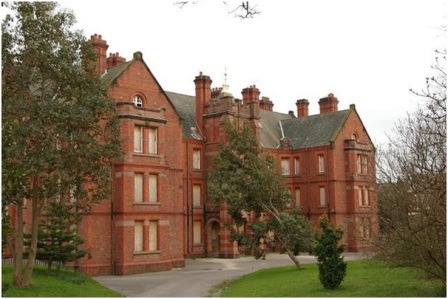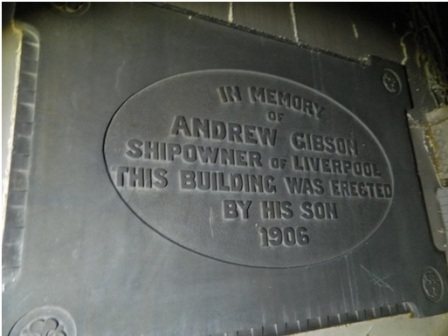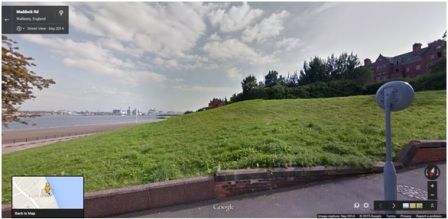Press release: SAVE calls on Sailors’ union Nautilus not to sink Mersey maritime landmark
The imposing Andrew Gibson House was completed in 1906, the gift of a wealthy Liverpool cotton merchant, to provide a sanctuary for the widows of elderly sailors and men lost at sea. The massive sandstone and brick edifice stands in its own landscaped grounds on the Wirral side of the River Mersey, and commands unrivalled views across to the famous city skyline, which is designated by UNESCO as one of the most important heritage landscapes in the world.
Its owners, merchant navy union Nautilus, formerly NUMAST, have managed the building and its extensive Marine Park retirement estate for over a century. The complex is an inspiring example of both Edwardian philanthropy and collective welfare, funded by the generosity of Andrew Gibson and constructed by his son in his memory, supported by union member subscriptions.
SAVE considers that it is a historic and soundly built asset, a memorial to Merseyside's maritime history, union solidarity and Edwardian philanthropy. Bequests of such size and grandeur are increasingly rare, especially those directly for the benefit of women.
For decades, few passers-by realised what the building was or knew its name, because a covenant stipulated that no sign be put outside saying its identity or purpose, to protect the widows who lived there.
Until about a decade ago the building was in use and in good order, but it has since been left empty and has become increasingly derelict. Nautilus has now applied to the local authority, Wirral MBC, for prior approval to demolish the complex who will meet to determine the decision in the next two weeks. Surprisingly, the building is unlisted, and the prominent site is likely to be sold for the development of waterside flats.
SAVE calls on the General Secretary of Nautilus, Mark Dickinson and the Chairman of Trustees John Lang, to reconsider their approach. We urge them to work with the local authority, Wirral MBC, that supports renovation, and bring this attractive and historically important building back into use. SAVE is supported by Liverpool's former World Heritage Site Officer, John Hinchliffe.
John Hinchliffe writes: "The interior was remodelled in the 1980s from 40 bed-sitting rooms to 25 self-contained apartments but it retains the original plan form of the communal rooms; its original staircase with cast iron newel post and balusters; the original door-screen of the front door with some stained glass; some plaster cornices; the commemorative plaque and; an early lift hoist engine."
The building has already demonstrated that it is ideal for repurposing to apartments, indeed the local authority has already granted permission for conversion, and has approved permission for some enabling development on the grounds. The building remains in essentially good order, requiring mainly remedial works to its roof and services.
In addition, there has been interest from several developers and at least three housing associations have expressed interest in converting the building.
SAVE Director Clem Cecil says: "We urge Nautilus to recognise the value of Andrew Gibson House and work with the council and those interested in developing it to convert it rather than demolish it. We would be happy to work with Nautilus to help identify a future for the building."
SAVE campaigner and Liverpool planning expert Jonathan Brown says: "The history of seafaring and the heritage of paternalism and collective welfare are integral to the identity of Merseyside and indeed the UK. Yet without living monuments to these proud traditions, and a willingness to cherish and re-use them, their legacy will disappear forever."
SAVE President Marcus Binney says: "Liverpool is a World Heritage Site in recognition of its great maritime history. Birkenhead, across the water, is part of this history and the home a splendid maritime landmark which can be a model conversion to residential use, a delight to the new residents with its wonderful views and a major point of interest to every passerby. Decent solidly built Edwardian buildings standing on fine sites must not be trashed."
An online petition has been set up to allow the public to support SAVE's campaign:
https://you.38degrees.org.uk/petitions/save-andrew-gibson-house-in-wirral?source=facebook-share-button&time=1422449701
A Note on Andrew Gibson House by John Hinchliffe, former Liverpool World Heritage Site Officer
Architectural Interest:
Andrew Gibson House is an imposing edifice in the simplified symmetrical Edwardian baronial style. It stands assertively on the high ground - a landmark building on the west bank of the River Mersey which is highly prominent and provided views over the river for its residents whose husbands spent much of their lives at sea.
It is constructed of red/brown common brick, red stock bricks and pink/buff sandstone. It has a steeply pitched blue slate roof, articulated by huge ribbed chimneys and dormer gables. It has 4/5 storeys with the upper floor accommodation partly in the roof space. Both principle elevations have three projecting bays. The central bay of the front (W) elevation is a three storey tower constructed in bands of brick and sandstone. At ground floor of the tower, the recessed doorway has a flat segmental lintel with a keystone. Above that is a segmental arch/spandrel with rosettes and recessed gothic panels. The top of the tower has a stepped solid parapet enclosing a pyramidal slated tower which supports a weather vane. All other projecting bays are 3 or four storeys high and have gables topped by sandstone copings and dressings. Each gabled projection has a tall bay window with a stone parapet and an oeil de bouef (bull's-eye) window above.
The house retains its original grounds and most of its brick boundary wall with stone copings and gate-piers. The original plans are in the Local Records Office and confirm that it was designed by "Fry Architect."
Historical Interest:
Andrew Gibson House was opened in 1906. It represents a significant stage in the development of the wider Mariners' Park for Aged Seamen. The concept behind the park was established by the Mercantile Marine Service Association which was founded in 1857 to improve the conditions and status of British ship-masters and officers. The first 2 cottage houses were opened in 1882, the same year in which the Home for Aged Seamen (later renamed Cliff House) was opened. The park has evolved since that time, including the erection of Gibson House at the beginning of the 20th C and the erection of new, some demolitions and the erection of The Hub (a block of 18 new apartments for former seamen at the beginning of the 21st C.
Gibson House was built specifically to provide accommodation for the widows of merchant Navy ship-masters and officers. It is a nationally rare example of this building type and remains as testament to welfare provision for the widows of seamen.
Gibson House was the philanthropic bequest from the son of Andrew Gibson in his father's memory. It is tangible evidence of a tradition of philanthropy at the wider site: the land for the Mariners' Park was donated by Roger Lyon Jones; the first 2 cottages were the bequest of the wife of George William Slack; Cliff House was built at the expense of the merchant William Cliff in memory of his daughter Rosa; 7 of the apartments in Gibson House were the endowments of local people or organisations associated with maritime activities and; other elements of the site were also the result of bequests.
Liverpool's ‘Endangered' Maritime Mercantile World Heritage Site:
Liverpool was inscribed on to UNESCO's World Heritage list in 2004 as being of universal human value as the supreme example of a commercial port of the 18th, 19th and early 20th Cs. Liverpool achieved its commercial success due to a wide range of factors and people but the sailors and ship-masters who sailed the ships were central to that success.
Although Andrew Gibson House is outside the WHS, it is closely associated with it both thematically and physically (on the opposite side of the river), and it contributes to the outstanding universal value of Liverpool's global influence.
UNESCO has placed Liverpool on its World Heritage List in Danger and has demanded the UK Government submit to the World Heritage Centre, by 1 February 2015, an updated report, including a 1-page executive summary, on the state of conservation of the property for examination by the World Heritage Committee at its 39th session in 2015.
Comments:
Gibson House is a non-designated heritage asset of great historic significance and some architectural significance and survives as part of a wider ensemble of welfare buildings associated with Merseyside's maritime heritage. It survives with substantial authenticity and integrity, albeit currently in poor condition. It is a major landmark in the locality when viewed from the river, its west promenade and from Seabank Road. English Heritage has recognised the importance of the historic institutional buildings of Liverpool in its publication "Building a Better Society" (Colum Giles 2008).
The rise of Liverpool to become one of the world's greatest seaports relied upon many factors, one of which was the necessity for sailors and ship-masters but Giles states (Page 61): "Among the most vulnerable sections of Liverpool society were seamen and their families...Charity came to the rescue of both parties." Andrew Gibson House is tangible evidence of a late example of that charity and a nationally rare example of accommodation which was provided specifically for widows of seamen.
The outstanding universal value of Liverpool's World Heritage Site as the best example of a commercial port of its period was accepted by UNESCO in 2004. The boundaries of the WHS and its Buffer Zone were necessarily fixed in accordance with the Operational Guidelines but current thinking from UNESCO stresses the importance of understanding and protecting the wider historic urban landscape. UNESCO also promotes an understanding of intangible heritage and that heritage assets extend beyond fixed boundaries.
Although on the opposite side of the river from the WHS and outside its boundary, Gibson House is inextricably linked to the theme of Liverpool's WHS and it should be recognised as a supporting structure to the theme of the WHS. English Heritage's "Designation Listing Selection Guide - Maritime and Naval Buildings" also recognises the significance of Welfare Buildings and states at P6:
"Buildings devoted to the welfare of seamen also warrant consideration...(especially where they)..are testaments to the international character of England's major ports and her prominent role in the story of European migration."
Homes for seamen and their families are not referred to in English Heritage's "Designation Listing Selection Guide Health and Welfare Buildings" but they are an extension of the principle established by Almshouses, which are referred to as a building type for the welfare of specific sectors of society. The guide states: "...great care needs to be taken to balance the quality of the architecture of the whole with the historic significance of a particular part."
Gibson House has both architectural merit as an imposing edifice and historic significance as a nationally rare building type, as a sanctuary for the widows of elderly sailors and men lost at sea - the gift of a wealthy Liverpool cotton merchant.
For more information and images, please contact the SAVE Office on 0207 253 3500 or office@savebritainsheritage.org, or Clem Cecil on 07968 003 595, or Jonathan Brown on 07806 590 325



